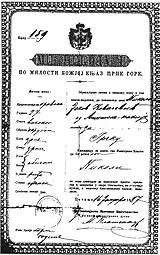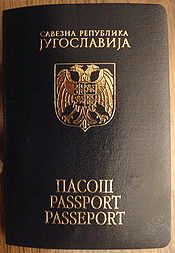- Montenegrin passport
-
The Montenegrin passport (Montenegrin: pasoš) is the primary document of international travel issued by Montenegro.
The passport is issued by the Ministry of Interior or, if the citizen resides abroad, at the embassy. Besides serving as proof of identity and of citizenship, they facilitate the process of securing assistance from Montenegrin consular officials abroad, if needed. Citizens can not have multiple passports at the same time.
Contents
History
The first passports issued in Montenegro are from the 18th century, by Prince-Bishop Vasilije III Petrović-Njegoš.
After Vasilije ethnicity was never a part of Montenegrin passports again. During the reign of Prince-Bishop Petar I Petrović-Njegoš, a special document known as "Passport" (Serbian: Пашепорт) was granted to the citizens who wanted to wanted extraordinarily to visit foreign countries.
During the reign of Prince-Bishop Petar II Petrović-Njegoš, he was granting a special Montenegrin Bill of Passage. From then on, next to every user of the bill and subsequent passports, "Montenegrin" was added, relating to the country of his or her birth. It also introduced the notification from which clan is the individual. Later, Njegos formally instituted as the official name name "Montenegrin Passport".[1] A component part of it was the Seal of the Cetinje Metropolitanate's Righteous Soviet, a bicephalic white eagle with spread out wings, an Eastern Orthodox cross between his heads and a passing lion beneath it, altogether on red background.
With the secularization of Montenegro as a formal Princedom under Prince Danilo I Petrovic-Njegos, religious affiliation and even physical description of the passport holder were introduced as of the mid 19th century, in attempt to prevent fraud[2]. The Seal was replaced with Danil's Coat of Arms, the lion was moved onto a red shield on the eagle's chest, while an Imperial crown was added .

 Passport issued in Montenegro in 1887. Prior to the advent of photography, passports had a description of the bearer (left) and the front cover of the Federal Republic of Yugoslavia passport (right).
Passport issued in Montenegro in 1887. Prior to the advent of photography, passports had a description of the bearer (left) and the front cover of the Federal Republic of Yugoslavia passport (right).The passports issued by Nikola I Petrovic-Njegos were significantly changed in appearance, also losing any reference to nationality[3]. The same were the unrecognized passports published by the Montenegrin Government in Exile in 1919, after the country's annexation by Serbia.
Following the breakup of Yugoslavia, passports were issued in order with the “Law on Travel Documents of Yugoslav Nationals” which came into force on 26 July 1996, although the country came into existence in 1992. They were navy blue in color and have two inscriptions in golden letters - Савезна Република Југославија (Federal Republic of Yugoslavia) at the top and the word passport written in three languages: Serbian (Cyrillic script), English and French at the bottom divided by the coat of arms. Following the restructuring of the FRY into the State Union of Serbia and Montenegro in 2003, passports with the new name were not issued due to the expected breakup of the union, which eventually happened in 2006.
Following Montenegro's independence, citizens of Montenegro used the same travel document as Serbia until 2008, the only difference being in issuing authority, in this case Ministry of Interior of Montenegro.
On 30th November 2006, the Government adopted the Memorandum of Agreement between the Republic of Montenegro and the Republic of Serbia on Consular Protection and Services to the Citizens of Montenegro. By this agreement, Serbia, through its network of diplomatic and consular missions, provides consular services to the Montenegrin citizens on the territory of states in which Montenegro has no missions of its own.
On 1st January 2010, the Government officially invalidated all non-biometric Montenegrin passports, even if the expiry date was beyond the 1st January 2010. Because non-biometric Montenegrin passports were no longer considered valid travel documents from that date onwards, holders were obliged to apply for new biometric Montenegrin passports in order to travel. [4]
Appearance
Design
The current passports are burgundy red with the Montenegrin coat of arms. The data page is printed in Montenegrin, English and French. Unlike the passports issued through history of Montenegro, which used both the Cyrillic and Roman alphabets, the current Montenegrin passport uses the Roman script exclusively.
Identity information page
The passport includes the following data:
- Country code ('MNE' for Montenegro)
- Nationality ('MNE' for Montenegrin )
- Type ('P' for passport)
- Passport serial number
- Name of bearer
- Place of birth
- Date of birth (DD.MM.YYYY.)
- Sex
- National identity number (JMBG)
- Date of issue (DD.MM.YYYY.)
- Date of expiry (DD.MM.YYYY.)
- Issuing office (Ministry of Interior of Montenegro)
- Signature and photo of bearer
The information page ends with the Machine Readable Zone and the identity page also contains the RFID chip.
Languages
The data page is printed in Montenegrin, English and French, while the personal data is entered in Montenegrin.
Types
Passports that can be issued are:
- Ordinary passport is issued to all citizens.
-
- Valid for 10 years
- Collective passport is issued to groups traveling together.
-
- Valid for a single trip abroad.
- Though it is not primary means of international travel for organized groups, it is often used to facilitate the issuance of visas, or to decrease administrative costs if a lot of group members do not have their individual passports. Main users of these passports are high schools and tourist agencies.
- Collective passport can be used for travel only to specific, usually nearby, countries. Some countries that do not accept collective passport as valid travel ID, do issue collective visas, but still stamp individual passports.
- All members of the group must cross the border at the same time and be part of the same organized trip.
- Diplomatic passport is issued by the Ministry of Foreign Affairs to diplomats, high-ranking officials, members of the parliament and persons traveling on official state business, and in some cases to immediate family members of the above.
-
- Validity is determined by the nature of the position held - diplomats and officials will usually receive the passport covering their mandate in office.
- Official passport is identical in all aspects to the diplomatic passport, but lacks the privileges of diplomatic immunity. It is issued to mid and low-ranking officials, as well as to non-diplomatic staff at the embassies and consulates.
Visa requirement for Montenegrin citizens
Main article: Visa requirements for Montenegrin citizensHolders of a Montenegrin passport may travel without a visa, or with a visa received upon arrival, to about 100 countries.[5]
Entry refusal in Malaysia
Montenegrin citizens were previously not allowed to enter Malaysia, however the admission is now not refused when the passenger has obtained a visa and a special permission from the Ministry of Home Affairs for a maximum stay of 30 days.[6][7] Citizens of Montenegro, Serbia and Israel remain the only three countries banned from participating in Malaysia My Second Home program.[8][9]
Documents required
The following documents are required in order to obtain passport[10] :
- Old passport (if applicable, regardless of expiry date)
- National ID card (adults only)
- Birth certificate or Certificate of citizenship, and Residence certificate
- Certificate of citizenship (not older than 6 months)
- Issuing charge (€15,00)
- Proof of administrative taxes paid (€25,00)
See also
- Visa requirements for Montenegrin citizens
- Visa policy of Montenegro
- Montenegrin identity card
- Montenegrin nationality law
- List of passports
References
- ^ http://www.njegos.org/passports/pasos1.jpg
- ^ http://www.njegos.org/passports/pasos3.jpg
- ^ http://www.njegos.org/passports/pasos4.jpg
- ^ INVALIDATED PASSPORTS, EFFECTIVE 1 JANUARY 2010
- ^ Countries into which Montenegrin nationals may enter without a visa, Ministry of Foreign Affairs
- ^ The government of Malaysia refuses admission to nationals of Montenegro. However, if holding a letter of approval from the Malaysian Ministry of Home Affairs, admission is allowed; Visa required. - "Visa information - Malaysia". NWA. http://www.timaticweb.com/cgi-bin/tim_website_client.cgi?SpecData=1&HEALTH=1&VISA=1&page=health&NA=RS&AR=00&EM=RS&PASSTYPES=PASS&DE=MY&selDest=Malaysia&selTrans=Use+ctrl-key+to+select+or+deselect+transit+point%28s%29+above&selVisi=Use+ctrl-key+to+select+or+deselect+visited+countries+above&Submit=++Submit++&user=NWB2C&subuser=NWB2C. Retrieved 19 December 2009.
- ^ "Visa Requirement By Countries". Department of Immigration, Malaysia. http://imi2.imi.gov.my/eng/perkhidmatan/im_Visa.asp. Retrieved 19 December 2009.
- ^ malaysia-trulyasia.com/tourism
- ^ mida.gov.my/beta/pdf/expatriatemsia2007.pdf
- ^ "Putne isprave i vize (in Montenegrin)", Ministry of Internal Affairs of the Republic of Montenegro. Retrieved 14 Jun 2007.
External links
- Ministry of Foreign Affairs
- Njegoskij|org :: European Commission launches dialogue with Montenegro on visa-regime liberalisation (with photos of the new Montenegrin identity papers: passport, ID card, driving licence)
- Njegoskij|org :: 33 top university students rewarded by receiving the first new Montenegrin passports
Passports (gallery) By continent AfricaAlgeria · Angola · Benin · Botswana · Burkina Faso · Burundi · Cameroon · Cape Verde · Central African Republic · Chad · Comoros · DR Congo · Rep. Congo · Côte d'Ivoire · Djibouti · Egypt · Equatorial Guinea · Eritrea · Ethiopia · Gabon · The Gambia · Ghana · Guinea · Guinea-Bissau · Kenya · Lesotho · Liberia · Libya · Madagascar · Malawi · Mali · Mauritania · Mauritius · Morocco (Western Sahara1) · Mozambique · Namibia · Niger · Nigeria · Rwanda · São Tomé and Príncipe · Senegal · Seychelles · Sierra Leone · Somalia (Somaliland1) · South Africa · South Sudan · Sudan · Swaziland · Tanzania · Togo · Tunisia · Uganda · Zambia · ZimbabweAsiaAfghanistan · Azerbaijan (Nagorno-Karabakh1) · Bahrain · Bangladesh · Bhutan · Brunei · Burma · Cambodia · People's Republic of China (Hong Kong SAR · Macau SAR) · Cyprus (Northern Cyprus1) · East Timor · Georgia (Abkhazia1 · South Ossetia1) · India · Indonesia · Iran · Iraq · Israel (Palestine1) · Japan · Jordan · Kazakhstan · Kuwait · North Korea · South Korea · Kyrgyzstan · Laos · Lebanon · Malaysia · Maldives · Mongolia · Nepal · Oman · Pakistan · Philippines · Qatar · Saudi Arabia · Singapore · Sri Lanka · Syria · Republic of China (Taiwan)1 · Tajikistan · Thailand · Turkey · Turkmenistan · United Arab Emirates · Uzbekistan · Vietnam · YemenEuropeAlbania · Andorra · Armenia · Austria · Belarus · Belgium · Bosnia and Herzegovina · Bulgaria · Croatia · Czech Republic · Denmark · Estonia · Finland · France · Germany · Greece · Hungary · Iceland · Ireland · Italy (SMO of Malta1) · Latvia · Liechtenstein · Lithuania · Luxembourg · Macedonia · Malta · Moldova (Transnistria1) · Monaco · Montenegro · Netherlands · Norway · Poland · Portugal · Romania · Russia · San Marino · Serbia (Kosovo1) · Slovakia · Slovenia · Spain · Sweden · Switzerland · Ukraine · United Kingdom (Anguilla · Bermuda · BN(O) · British Virgin Islands · Cayman Islands · Falkland Islands · Gibraltar · Guernsey · Jersey · Isle of Man · Montserrat · Pitcairn Islands · Saint Helena · Turks and Caicos Islands) · Vatican CityNorth AmericaAntigua and Barbuda · Bahamas · Barbados · Belize · Canada · Costa Rica · Cuba · Dominica · Dominican Republic · El Salvador · Grenada · Guatemala · Haiti · Honduras · Jamaica · Mexico · Nicaragua · Panama · Saint Kitts and Nevis · Saint Lucia · Saint Vincent and the Grenadines · Trinidad and Tobago · United States (Iroquois League1)OceaniaAustralia · Fiji · Kiribati · Marshall Islands · Federated States of Micronesia · Nauru · New Zealand · Palau · Papua New Guinea · Samoa · Solomon Islands · Tonga · Tuvalu · VanuatuSouth AmericaCommon-designs Andean Community of Nations · Caribbean Community · Central America-4 · Economic and Monetary Community of Central Africa · Economic Community of West African States · European Union (Laissez-Passer) · MercosurInternational
organizationsBy type Defunct British Indian Empire · British Mandate for Palestine · Czechoslovakia · East Germany · League of Nations refugee · Soviet Union · UNMIK Travel Document · YugoslaviaOther Notes 1 Unclassified by the United Nations geoscheme due to its non-membership in the UN. It is listed following the member state the UN categorises it under.Categories:- Passports by country
- Government of Montenegro
Wikimedia Foundation. 2010.



